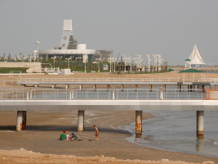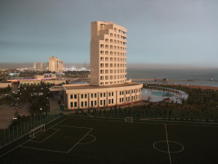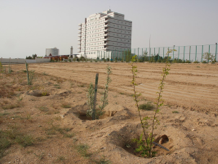Turkmenistan 2015

The Dani of Papua
From Houston to Sydney 2013
The itinerary I have followed on this trip has been quite different from my travels in 2006. On that trip, I visited several places not included this time, such as Nokhur (in the south-west of Turkmenistan), Konye-Urgench (in the far north), Mary, Gonur and Merv (all in the east) and Turkmenabad (in the north-east). This time, my Big New Area to visit was Turkmenbashi (also spelt Türkmenbaşy), formerly known as Krasnovodsk before Turkmenistan’s first President re-named the city after himself.
Turkmenbashi (the city, not the dead President) is located in the far west of Turkmenistan on the eastern shore of the Caspian Sea. With a population of about 75,000 people, it is the nation’s ninth largest city – perhaps an expression of Niyazov’s humility that he didn’t choose to name the country’s capital and largest city after himself, but settled for the ninth largest instead?
Turkmenbashi is largely an industrial city, housing Turkmenistan’s largest oil refinery, and it is Turkmenistan’s gateway to the Caucasus through its port and ferry service to Baku in Azerbaijan. Unlike Ashgabat, most of Turkmenbashi still shows its Soviet era architecture, set against quite a spectacular backdrop of almost sheer cliffs towering over the city.
Getting to Turkmenbashi involved a one hour flight on a Turkmenistan Airlines Boeing 737-700. I was very fortunate to have a window seat, which provided me with some great views of Ashgabat upon departure and some of the nearby irrigation areas before cloud cover obscured the view for most of the rest of the flight. The flight was due to depart at 8:30 am, but it was delayed for two hours due to foggy weather conditions in Turkmenbashi. When we stepped out of Turkmenbashi’s gleaming new airport terminal, under the huge portrait of a smiling President Berdimuhamedow, it was immediately obvious that we were about to experience considerably cooler temperatures than we had left behind us in Ashgabat.
The drive from the airport into downtown Turkmenbashi was interesting rather than scenic. It involved a long descent through a narrow road cutting that was apparently made by Japanese prisoners during World War II before we emerged onto the narrow coastal strip that housed the city’s huge oil refinery, flanked by a huge welcoming billboard featuring a smiling, waving President Berdimuhamedow.
Our first stop was at the city’s markets, known as the Dayhan Bazaar. This was a tiny enterprise compared with the huge markets in Ashgabat, and considerably less colourful as there were no live animal sales. Apart from a large open shed selling vegetables and a row of small open stalls selling fruit, most of the market comprised rows of little enclosed specialty stores that were remarkable only for their lack of remarkableness.
As our flight had arrived two hours late, our next stop following the markets was lunch at a restaurant overlooking the Caspian Sea. Somewhat disconcertingly, there were the remains of a former floating restaurant just outside, no longer floating and perched at a precarious angle that seemed perfect for local fishermen to spend a relaxing afternoon with their fishing poles.
The first part of the afternoon was spent exploring a series of sights in Turkmenbashi. Our first stop was the war memorial, featuring a statue of Atamurat Niyazov (President Niyazov’s father) in a military uniform with his hand over his heart, overlooking an eternal flame. The war memorial was located across the road from the city’s ornate railway station that was built in 1895.
Our second stop was at an exquisitely maintained Tsarist-era Russian Orthodox Church, located in a fairly run-down suburban area not far from the city centre. Despite its somewhat drab exterior, the church was beautifully restored inside, and seemed to be used actively as several women came in to light candles and pray.
Our third stop was at an unmistakably Soviet-era statue of a woman holding up her child as they both looked longingly from the hill towards the sea, waiting for their men to return home.
Our fourth and final stop in Turkmenbashi was at a tall concrete monument featuring effigies of two men, one Russian and one Turkmen, with a bold number “100”. The monument was built in 1969 to symbolise the centenary of the establishment of the city and the enduring friendship between the Russian and Turkmen peoples.
Beside the monument is a small building that is part of the Regional History Museum. We didn’t venture inside the museum, but it was interesting to learn that the building was once part of the old fort that guarded the town against attack from the sea. The military origins of the building could be seen by looking at the recesses in the building’s foundations, as these had once been used as cavities for guns to defend the building. A less impressive aspect of the building were the renovations to the exterior, where stones seem to have been replaced by painted Styrofoam blocks.
Having seen the most impressive of Turkmenbashi’s sights, we drove to the east into what must be one of Turkmenistan’s most bizarre sights (and that’s a high bar to jump!) – the Awaza National Tourist Zone.
Once a sleepy strip of sand with just a few dachas and small villages, 12 kilometres west of Turkmenbashi on the Caspian Sea seafront, Awaza (which is sometimes spelt Avaza) was declared a national tourist zone in 2007 as one of the first projects of President Gurbanguly Berdimuhamedow following Niyazov’s death. So far, more than US$2 billion has been invested in the area to build a string of high rise hotels with extravagant architecture, an eight kilometre long ornamental canal for sightseeing, lined with restaurants and water features, and various parks and open spaces dotted with cultivated trees and shrubs. The Caspian shoreline does not feature good quality beaches, so large quantities of sand have been spread alone the shoreline in an attempt to create attractive beaches.
We arrived at Awaza in the mid-afternoon, and after some circuitous driving to try and find the boat pier, we stepped onto one of the sightseeing boats to take a tour along the canal. The weirdness became ever more evident as we cruised the canal, looking out to the string of massive construction projects and infrastructure development. There seemed to be just one problem – we were the only visitors in the entire Awaza zone. Every hotel was empty (or under construction) except ours, and we were the only guests in our hotel. Our hotel, the Serdar Hotel, was one of the first ones built in Awaza, and yet I could easily have thought that I was the first person ever to stay in my room had it not been for the toenail clippings I found on the carpet.
We had a couple of hours before dinner would be ready, so while a hardy few took a swim in the (very) cold waters of the Caspian Sea or relaxed on the artificially sand nourished beach, I went to a walk along the waterfront promenade past several of the other – invariably empty – hotels. I saw just four other people on a beach during my walk, a warmly dressed local Turkmen family having tea from a large thermos sitting on wet sand under the shelter of a pier walkway.
I understand that the hotels in Awaza sometimes have guests. Most are owned by government ministries, and Awaza is therefore sometimes used as a conference venue. In summer, the hotels are also used for incentive holidays for employees for various ministries. In this mid-May, though, it was difficult to see much return on investment for the US$2 billion that has reportedly been spent so far.

Day 5 - Turkmenbashi and Awaza
Wednesday
13 May 2015








































